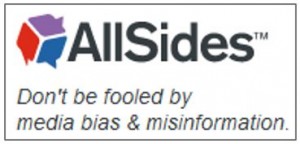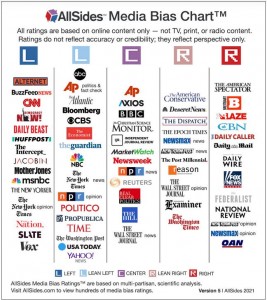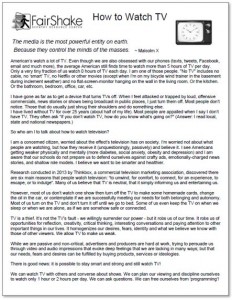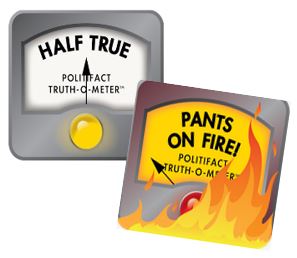We currently have all the capacity, expertise, programs, leaders, regulations, and wealth required to end unnecessary suffering and create an alternative future.
- Peter Block |
How to Watch TV
“What is happening here is that television is altering the meaning of ‘being informed’ by creating a species of information that might properly be called disinformation. Disinformation does not mean false information. It means misleading information—misplaced, irrelevant, fragmented or superficial information—information that creates the illusion of knowing something but which in fact leads one away from knowing.”
~ Neil Postman Amusing Ourselves to Death
 We rely on the news for information. We watch TV shows and streaming videos to relax. But the companies who make and market the TV shows and news shows prey on our ‘receptive mode’ to also sell things…including the idea that we need more stuff. Stuff to make us feel better. Stuff to make sure we’re not ‘missing out’, Stuff to help us express our our unique selves.
We rely on the news for information. We watch TV shows and streaming videos to relax. But the companies who make and market the TV shows and news shows prey on our ‘receptive mode’ to also sell things…including the idea that we need more stuff. Stuff to make us feel better. Stuff to make sure we’re not ‘missing out’, Stuff to help us express our our unique selves.
There was a time when news services had an obligation to report fairly on news stories. Those days are long gone. We get frustrated with ‘fake’ news, but all news broadcasts tell limited stories; and those stories are told through the lens of an underlying agenda. This does not mean the agenda is to dupe you, but it is always meant to persuade you.
The media is the most powerful entity on earth. Because they control the minds of the masses. ~ Malcolm X
From Wikipedia: The fairness doctrine of the United States Federal Communications Commission (FCC), introduced in 1949, was a policy that required the holders of broadcast licenses both to present controversial issues of public importance and to do so in a manner that was honest, equitable, and balanced. The FCC has not enforced the fairness doctrine since 1985 and eliminated the policy all together in in 1987.
There was also a time when pharmaceutical companies could not advertise to us on television. Even though an insufficiently-tested, toxic arthritis drug called “Oraflex” was recalled after only five months on the market, restrictions to Direct-To-Consumer (DTC) marketing were completely lifted in 1985.
Basically, we have been set adrift, without any preparation or protection, into a sea of powerful marketing and information-manufacturing since 1985. It is up to make good choices! But where are we taught to critically weigh out our choices…or even know what our choices are?
Today we argue about ‘fake news’. A story half-told is fake, through the deception of withholding information. Where can we learn about bias in the news? How can we understand the ‘whole story’? How can we learn to discern the information that is presented to us?
One suggestion I have is to do a search on a topic. First put the term in the search box and see what comes up. Then put the term plus the word “controversy” or “debate” after it: (for instance: advertising pharmaceutical drugs controversy or debate) and you’ll find a different perspective in the results.
 AGENDA-FREE TV
AGENDA-FREE TV
Watch the news, as it unfolds, with no political agenda! Steve Lookner, amazing and diligent news anchor, is committed to using wide-ranging research and contacts so he can keep us abreast of news stories and offer more complete information, since bias and advertising cloud the telling of the whole story in mainstream media.
 All Sides
All Sides
www.allsides.com/unbiased-balanced-news
This service certainly does not share ‘All Sides’ of the daily news, but they share several sides of the mainstream media. Check out the chart to the right on their website to find out more about political bias in the news.
allsides.com/unbiased-balanced-news
Politifact is “a fact-checking website that rates the accuracy of claims by elected officials and others who speak up in American politics”. They do this to “to give citizens the information they need to govern themselves in a democracy.”
Click here to check out their diverse issues!
————————————————
 HOW TO WATCH TV Printable PDF
HOW TO WATCH TV Printable PDF
American’s watch a lot of TV.
Even though we are also obsessed with our phones (texts, tweets, Facebook, email and much more), the average American still finds time to watch more than 5 hours of TV per day. Only a very tiny fraction of us watch 0 hours of TV each day. I (Sue) am one of those people. This includes no cable, no ‘smart’ TV, no Netflix or other movies (except when I’m on my bicycle wind trainer in the basement during inclement weather) and no flat-screen-monitor hanging on the wall in the living room. Or the kitchen. Or the bathroom, bedroom, office, car, etc.
I have gone as far as to get a device that turns TVs off. When I feel attacked or trapped by loud, offensive commercials, news stories or shows being broadcast in public places, I just turn them off. Most people don’t notice. Those that do usually just shrug their shoulders and do something else.
I have lived without TV for more than 30 years (about half of my life). Most people are appalled when I say I don’t have TV. They often ask “If you don’t watch TV, how do you know what’s going on?” (Answer: I read local, state and national newspapers.)
So who am I to talk about how to watch television?
I am a concerned citizen, worried about the effects television has on society. I’m not worried about what people are watching, but how they receive it (unquestioningly, passively) and believe it. I see Americans getting weaker physically and mentally (more diabetes, social anxiety, obesity and depression) and I am aware that our schools do not prepare us to defend ourselves against crafty ads, emotionally-charged news stories, and shallow role models. I believe we want to be smarter and healthier.
Research conducted in 2013 by Thinkbox, a commercial television marketing association, discovered there are six main reasons that people watch television: “to unwind, for comfort, to connect, for an experience, to escape, or to indulge”. Many of us believe that TV is neutral, that it simply informing us and entertaining us.
However, most of us don’t watch one show then turn off the TV to make some homemade cards, change the oil in the car, or contemplate if we are successfully meeting our needs for both belonging and autonomy. Most of us turn on the TV and don’t turn it off until we go to bed. Some of us even keep the TV on when we sleep or when we are alone, as if we are somehow safe or connected.
TV is a thief. It’s not the TV’s fault – we willingly surrender our power – but it robs us of our time. It robs us of opportunities for reflection, creativity, critical thinking, interesting conversations and paying attention to other important things in our lives. It homogenizes our desires, fears, identity and what we believe we know with those of other viewers. We allow TV to make us weak.
While we are passive and non-critical, advertisers and producers are hard at work, trying to persuade us through video and audio impressions that evoke deep feelings that we are lacking in many ways; but that our needs, fears and desires can be fulfilled by buying products, services or ideologies.
There is good news: it is possible to stay smart and strong and still watch TV!
We can watch TV with others and converse about shows. We can plan our viewing and discipline ourselves to watch only 1 hour or 2 hours per day. We can ask questions. We can free ourselves from ‘programming’!
According to media theorist Neil Postman and journalist Steve Powers in their book How To Watch TV News, we should consider these principles when watching TV news:
1. Whatever someone says something is, it isn’t. What this means is the brief description used to describe an event does not fully describe the event. Try this with two other people: choose an event you experienced together. Have each person describe the event in two paragraphs. Compare your descriptions. Now consider how that relates to what you ‘learn’ on the news.
Lesson: Viewers should know that with all news, they learn just a fraction of any story.
2. Language operates at various levels of abstraction. Some language describes an event: In Westby, 6% more votes were cast today than during the previous election. Some language evaluates an event: A record number of voters flooded the polls today. Some language infers an event: Voters showed up in droves today, demanding to be counted.
Lesson: Be careful and critical watching the news to hear how the stories are told and punctuated.
3. Almost all words have connotative meanings. Connotation: an idea or feeling that a word invokes in addition to its literal or primary meaning. Example: when we use the word ‘judge’ we often imply that a person has formed a negative conclusion about something since we rarely use it to describe positive attributes or activities. Ex: “Don’t judge me.” But when we say “He’s really nice”, we are still judging him.
Lesson: Critique the words the anchors and actors use, especially words like important, love, reality, judge, relationship, faith, manly/womanly, motherly/fatherly and many others. (Start a list!) Consider if the word is used to evoke a particular feeling, and also if the word has further implications about roles and social expectations.
Fragmented pictures and accompanying music and sound effects: are used grip your attention and evoke feelings. Pay attention to the music and sounds which provide added tension (like it does in movies).
We want to believe that the news is a public service; provided to keep us informed, intelligent and abreast of the events that we need to know about to live in society together. (Aw, wouldn’t that be peachy?) But the ‘news’ is not that at all. The news offers a controlled view of the world; in addition to telling us about events, it entertains us, incites fear, generates money, and is filtered by political perspectives and advertisers. According to Postman and Powers: “The “news” is only a commodity, which is used to gather an audience that will be sold to advertisers.”
Activity: Consider where the money (or other influence) is coming from to produce the news, to entertain you, to inform you about history or science or health. (Interesting note: the words inform and information are not related in any way to truth or validation) Are they produced by companies with specific messages, ethics or goals? Are they supported exclusively by commercials?
According to Postman and Powers, there are two dimensions of commercials: money and social values.
Money: Advertisers pay for your attention. The shows with the most viewers are news shows. The average American watches over 39,000 commercials in a year.
Social Values: Advertisers want to sell us stuff (services or ideologies), but to motivate us to buy stuff we don’t need, they must make us feel things about ourselves. (If they used logic, we would not be duped in to feeling inadequate, we could see that we could share stuff, and that we could live with less stuff.)
Commercials are “all about serious money”, and they “are also about the serious manipulation of our social and psychic lives” say Postman and Powers. Most commercials have this basic premise: “whatever problem you face (lack of self-esteem, lack of attractiveness, lack of social acceptance) it can be solved, solved fast, and solved through a drug, a detergent, a machine or a saleable technique. One of the reasons commercials are so effective”, they add, is that “people do not usually analyze them.” Life’s problems, including moral dilemmas, “are to be solved through chemistry and technology.”
From How to Watch TV News:
For a market economy to work, the population must be made to believe that it is need of continuous improvement. If you are quite satisfied with your teeth, your hair, your 2003 Honda, and your weight, you will not be an avid consumer. The thematic thrust of advertising is to…get you to think about your inadequate self and how you can get better.
Does this cause you look at the advertisements for pharmaceutical drugs any differently?
Activity: Write down the commercials that go along with shows for at least 48 hours. Note the time, the show being watched and the commercials that are either just before, during or immediately after the show. When you’re done, see if you can find a pattern of the types of commercials with the types of shows. What does that tell you about who they think is watching and what they believe they can convince the viewer to purchase or do?
While we sit passively, the marketers, politicians and media organizations plot to persuade us. They hook us through our emotions while trying to convince us we are smart, rational thinkers. (Check out Dr. Zimbardo’s Resisting Influence piece in this packet) We believe we have a great deal of choice; that we can’t be that easily controlled; after all there are hundreds of channels! But according to Corporate Research Project, just “five major corporations are the gatekeepers and decision makers for the programming choices of the vast majority of the American people”.
You are in a great position to reflect on the authenticity of shows by considering the ‘reality’ prison shows. I’ve heard that people that they feel they have a greater understanding of prison life by watching these shows. What do you think? Is prison life as they portray it on TV? Is it constantly full of excitement? Does everyone have quick, smart and witty remarks? Do the people where you are – including you – look like the people in the shows? Your answers to these questions are the same answers that apply to all shows: dramas, comedies, reality shows and yes, even the history channel are not like real life.
Here are Postman and Powers’ eight recommendations for what to do when watching TV:
- When encountering a news show, you must come with a firm idea of what is important.
- In preparing to watch a TV news show, keep in mind that it is a ‘show’.
- Never underestimate the power of commercials.
- Learn something about the economic and political interests of those who run TV stations.
- Pay special attention to the language of newscasts.
- Reduce by at least one-third the amount of TV news you watch. (Read the news, too!)
- Reduce by one third the number of opinions you feel obligated to have.
- Do whatever you can to get schools interested in teaching children how to watch a TV news show
How To Watch TV News (2008) by Neil Postman and Steve Powers | Penguin Books NY, NY



